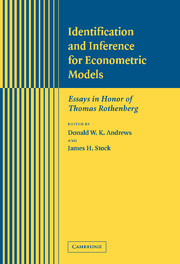Book contents
- Frontmatter
- Contents
- List of Contributors
- Preface
- Part I Identification and Efficient Estimation
- 1 Incredible Structural Inference
- 2 Structural Equation Models in Human Behavior Genetics
- 3 Unobserved Heterogeneity and Estimation of Average Partial Effects
- 4 On Specifying Graphical Models for Causation and the Identification Problem
- 5 Testing for Weak Instruments in Linear IV Regression
- 6 Asymptotic Distributions of Instrumental Variables Statistics with Many Instruments
- 7 Identifying a Source of Financial Volatility
- Part II Asymptotic Approximations
- Part III Inference Involving Potentially Nonstationary Time Series
- Part IV Nonparametric and Semiparametric Inference
2 - Structural Equation Models in Human Behavior Genetics
Published online by Cambridge University Press: 24 February 2010
- Frontmatter
- Contents
- List of Contributors
- Preface
- Part I Identification and Efficient Estimation
- 1 Incredible Structural Inference
- 2 Structural Equation Models in Human Behavior Genetics
- 3 Unobserved Heterogeneity and Estimation of Average Partial Effects
- 4 On Specifying Graphical Models for Causation and the Identification Problem
- 5 Testing for Weak Instruments in Linear IV Regression
- 6 Asymptotic Distributions of Instrumental Variables Statistics with Many Instruments
- 7 Identifying a Source of Financial Volatility
- Part II Asymptotic Approximations
- Part III Inference Involving Potentially Nonstationary Time Series
- Part IV Nonparametric and Semiparametric Inference
Summary
INTRODUCTION
That IQ is a highly heritable trait has been widely reported. Rather less well known are recent reports in major scientific journals such as those announcing that the heritability of controllable life events is 53 percent among women and 14 percent among men (Saudino et al. 1997), while the heritabilities of inhibition of aggression, openness to experience, and right-wing authoritarianism are respectively 12, 40, and 50 percent (Pedersen et al. 1989; Bergeman et al. 1993; McCourt et al. 1999). It seems that milk and soda intake are in part heritable, but not the intake of fruit juice or diet soda (de Castro 1993).
These reported heritabilities are parameter estimates obtained in structural modeling of measures taken on pairs of siblings – prototypically, identical (monozygotic) twins and fraternal (dizygotic) twins, some reared together and others reared apart. The models are of the linear random effects type, in which an observed trait – a phenotype – is expressed in terms of latent factors – genetic and environmental – whose prespecified cross-twin correlations differ by zygosity and rearing status. Estimation is by maximum likelihood applied to the phenotypic variances and covariances. Heritability, the key parameter of interest, refers to the proportion of the variance of the phenotype that is attributable to the variance of the genetic factors.
Regarding these studies, various issues arise. Those that I will touch on here include identification, nonnegativity constraints, alternative estimators, pretest estimation, conditioning of the design matrix, multivariate analyses, and the objectives of structural modeling.
- Type
- Chapter
- Information
- Identification and Inference for Econometric ModelsEssays in Honor of Thomas Rothenberg, pp. 11 - 26Publisher: Cambridge University PressPrint publication year: 2005
- 1
- Cited by



